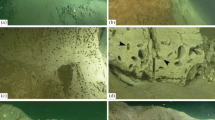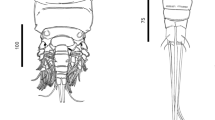Abstract
Photographic observations were carried out at depths of the shelf edge at the mouth of Uchiura Inlet, Suruga Bay, central Japan in order to clarify the life style of the isocrinid stalked crinoid,Metacrinus rotundus (Echinodermata). The distribution of the species was found to be restricted to a narrow area where boulders and rock outcrops were locally present. Mean density of the crinoid was 0.05 m−2, and this value was an order of magnitude smaller than that of the deeper isocrinid,Diplocrinus wyvillethomsoni, reported from the Bay of Biscay.Metacrinus rotundus formed a parabolic filtration fan with its arms recurved into the bottom current, and was thought to be a passive suspension feeder elevating the fan into the water column by its stalk. The distal half of the stalk lay along the hard substratum and about ten groups of cirri grasped the substratum. This mode of attachment was similar to that ofCenocrinus rather than that ofDiplocrinus. Metacrinus rotundus collect food at the layer between 10 and 50 cm above the sea floor, and do not utilize a higher layer even when this layer could be utilized by climbing over a larger boulder. Resuspended benthic materials are thought to be important as a food source forM. rotundus, and the crinoids seek not only locations of stronger currents but also the position where much resuspended matter is available.
Similar content being viewed by others
References
Carpenter, P.H. (1884a): Report on the Crinoidea collected during the Voyage of H.M.S. Challenger, during the years 1873–1876. The stalked crinoids. Challenger Rep.,11, 1–442.
Carpenter, P.H. (1884b): On three new species ofMetacrinus. Trans. Linn. Soc. Ser. 2 (Zool.),2, 435–446.
Conan, G., M. Roux and M. Sibuet (1981): A photographic survey of a population of a stalked crinoidDiplocrinus (Annacrinus) wyvillethomsoni (Echinodermata) from the bathyal slope of the Bay of Biscay. Deep-Sea Res.,28, 441–453.
Gislén, T. (1922): The crinoids from Dr. S. Bock's expedition to Japan 1914. Nova Acta Reg. Soc. Sci. Upsaliensis, Ser. 4,5, 1–183.
Gislén, T. (1924): Echinoderm studies. Zool. Bidr. Uppsala,9, 1–316.
Gislén, T. (1927): Papers from Dr. Th. Mortensen's Pacific Expedition 1914–16. 37. Japanese crinoids. Vidensk. Medd. Dansk Naturh. Foren.,83, 1–69.
Horikoshi, M. (1960): A topographical approach to a study of the benthic communities on the submarine ridge, Sé-no-umi, in Sagami Bay. Sci. Rep. Yokosuka City Mus.,5, 6–8.
Jumars, P.A. and E.D. Gallagher (1982): Deep-sea community structure: three plays on the benthic proscenium.In: The Environment of the Deep Sea, ed. by W.G. Ernst and J.G. Morin, Prentice Hall, New Jersey, pp. 217–255.
LaTouche, R.W. and A.B. West (1980): Observations on the food ofAntedon bifida (Echinodermata: Crinoidea). Mar. Biol.,60, 39–46.
Macurda, D.B. and D.L. Meyer (1974): Feeding posture of modern stalked crinoids. Nature,247, 394–396.
Macurda, D.B. and D.L. Meyer (1976): The identification and interpretation of stalked crinoids (Echinodermata) from deep-water photographs. Bull. Mar. Sci.,26, 205–215.
Marshall, N.B. (1979): Developments in Deep-Sea Biology, Blandford, Poole Dorset, 566 pp.
Matsuyama, M. and T. Teramoto (1985): Observations of internal tides in Uchiura Bay. J. Oceanogr. Soc. Japan,41, 39–48.
Messing, C.G. (1985): Submersible observations of deep-water crinoid assemblages in the tropical western Atlantic Ocean.In: Echinodermata, Proceedings of the Fifth International Echinoderm Conference, Galway, 24–29 September 1984, ed. by B. F. Keegan and B. D. S. O'Connor, Balkema, Rotterdam, pp. 185–193.
Meyer, D.L. (1982): Food and feeding mechanisms: Crinozoa.In: Echinoderm Nutrition, ed. by M. Jangoux and J.M. Lawrence, Balkema, Rotterdam, pp. 25–42.
Meyer, D.L. (1985): Evolutionary implications of predation on Recent comatulid crinoids from the Great Barrier Reef. Paleobiology,11, 154–164.
Meyer, D.L. and W.I. Ausich (1983): Biotic interactions among Recent and among fossil crinoids.In: Biotic Interactions in Recent and Fossil Benthic Communities, ed. by M.J.S. Tevesz and P.L. McCall, Plenum, New York, pp. 377–427.
Ohta, S. (1976): A precise and continuous monitoring system of the distance between the nearbottom instruments and the sea floor. J. Oceanogr. Soc. Japan,32, 65–73.
Ohta, S. (1983): Photographic census of large-sized benthic organisms in the bathyal zone of Suruga Bay, central Japan. Bull. Ocean Res. Inst., Univ. of Tokyo, No. 15, 1–244.
Oji, T. (1986): Skeletal variation related to arm regeneration inMetacrinus andSaracrinus, Recent stalked crinoids. Lethaia,19, 355–360.
Oji, T. (1987): Natural history of the Isocrinidae (Post-Paleozoic stalked crinoids) from Japan. Doctoral Dissertation, University of Tokyo, 77 pp.
Roux, M. (1980a): Découverte de sites à CrinoÏdes pédonculés (genresDiplocrinus etProisocrinus) au large de Tahiti. C.R. Acad. Sci. Paris, Ser. D,290, 119–122.
Roux, M. (1980b): Les CrinoÏdes pédonculés (Echinodermes) photographiés sur les dorsales océaniques de l'Atlantique et du Pacifique. Implications biogéographiques. C.R. Acad. Sci. Paris, Ser. D,291, 901–904.
Roux, M. (1985): Les CrinoÏdes pédonculés (Echinodermes) de l'Atlantique N.E.: Inventaire, écologie et biogéographie.In: Peuplements Profonds du Golfe de Gascogne, ed. by L. Laubier and C. Monniot, IFREMER, pp. 479–489.
Warner, G.F. (1977): On the shapes of passive suspension feeders.In: Biology of Benthic Organisms, ed. by B.F. Keegan, P.O. Ceidigh and P.J.S. Boaden, Pergamon, Oxford, pp. 567–576.
Author information
Authors and Affiliations
Rights and permissions
About this article
Cite this article
Fujita, T., Ohta, S. & Oji, T. Photographic observations of the stalked crinoidMetacrinus rotundus carpenter in Suruga Bay, central Japan. Journal of the Oceanographical Society of Japan 43, 333–343 (1987). https://doi.org/10.1007/BF02109286
Received:
Revised:
Accepted:
Issue Date:
DOI: https://doi.org/10.1007/BF02109286




